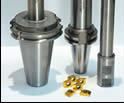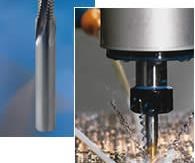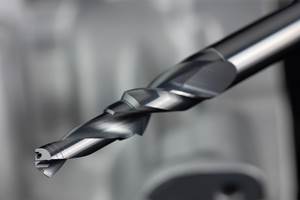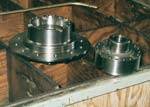A Time To Tap, A Time To Mill
Thread milling and tapping are two methods for machining threads in a hole. Tapping is more popular, but thread milling has several advantages that might be important in your application.
Tapping is not the only choice for machining threads in a hole—most shops know that. Most shops also know at least some of the advantages of thread milling, though the list is long. For example, a thread milling tool can address a range of hole diameters instead of just one hole size. The thread mill can place threads closer to the bottom of a blind hole, and it can machine threads in big holes with ease. The thread mill leaves room for chips to fall away. And the thread mill, unlike a tap, can combine various hole-making operations into a single tool. In short, there is a great deal that a thread mill can do.
However, most shops will continue to machine most of their threaded holes using taps. And there are good reasons for this.
Tapping is simple. In many ways, tapping is less demanding. Tapping can be done on a range of machines, at conventional speeds, without a helically interpolated tool path.
Alan Shepherd, technical director of Emuge—the Northborough, Massachusetts, supplier of taps and thread mills—routinely works with machining facilities to find the right thread-machining processes for their needs. The more demanding applications often call for thread milling, which solves a variety of challenges related to thread machining. But don't discount the value of a tap, he says.
"If you are machining mild steel—say, 20 parts with 10 threaded holes each—then go ahead and tap them," he says. "But if you have 150 of those parts, or if you are machining an exotic metal, then it may be time to consider thread milling." That is, provided the machine tool has that capability, he adds.
Mr. Shepherd applied his experience toward compiling the guidelines below. Based on his recommendations, what follows are variables to consider when determining which approach to thread machining makes the most sense.
Machine Tool
Tapping can be done on almost any machining center or milling machine. By contrast, thread milling requires—at the very least—a CNC machining center that can be programmed for helical interpolation.
Tapping can also be performed on lathes with rotary-tool capability. The need for helical motion tends to rule out thread milling on these machines.
Material
Tapping can be used in almost any material up to a hardness of 50 Rc. Thread milling can be used in materials up to 60 Rc.
When it comes to exotic metals, thread milling sometimes offers an easy way to machine threads that otherwise would be difficult to produce.
Speed
While tapping runs at relatively slow speeds, thread milling generally requires higher cutting speeds and feed rates. The helical tool path is long, so a high feed rate is needed in order to generate the thread within an efficient cycle time.
Pitch Diameter
The diameter of a tap is fixed, but the diameter that a thread milling tool can produce is more flexible. This latter diameter is determined by the CNC tool path instead of the tool, which means the diameter can change.
For example, the same tool could produce 1/4-20 UNC or 1/4-20 STI threads.
But a single tool could even be used when the nominal diameters are different. Through thread milling, for example, 1/2-14 NPT and 3/4-14 NPT threads could be produced without a tool change in between.
Multifunctionality
A tap can only be expected to tap. A thread mill, by comparison, can be designed to perform a variety of hole-making operations. One single tool could drill the hole, chamfer the hole, machine the thread and convolute it (cutting away the incomplete portion of the thread at the bottom).
Handedness
A tap can only produce the "hand" of the tap—right or left—that is ground into the tool. But a simple change in CNC programming can allow the thread mill to produce either a left- or right-hand thread.
(Another disadvantage of tapping is related to this design limitation. The tap has to be reversed at the end of the tapping operation, because it has to be "unscrewed" out of the hole. But a thread mill can just leave the cut and retract from the hole at a rapid rate.)
Depth, Part I
When the hole is blind, a tap can only reach so far. The tapered "point" of the tap will bottom out, leaving only incomplete threads for the rest of the depth of the hole.
A thread mill, with its flat bottom, doesn't have this problem. It can machine complete threads down deeper, closer to the bottom of the same blind hole.
Depth, Part II
By contrast, when the thread is particularly deep, a tap may shine. A long tap can machine threads effectively in a hole that goes a long way down. This is not the case with a thread mill. In thread milling, because the cutting forces are not balanced, the tool is prone to deflect. Beyond a certain depth, the deflection becomes too great to machine the thread well. In general, a thread mill is limited to a depth of about 2.5 times the diameter of the tool. (But non-traditional thread mill designs do address this limitation. See the shaded box above.)
Chips
The long continuous chip that is sometimes produced when certain materials are tapped can be a problem. The chip can bind in the hole and break the tool.
There is no problem comparable to this in thread milling. Like any milling operation, thread milling produces short, broken chips. Chip management is a common reason why shops choose thread milling.
Power
Taps are run at relatively slow spindle speeds. For this reason, the full, rated horsepower of the machine's spindle motor probably is not available to a tap. This usually is not a cause for concern—but it might be. A small machining center confronted with the need to tap a particularly large hole might lack the power to make this cut. For this small machine, thread milling expands the diameter of holes that the machine is able to thread successfully.
Related Content
Form Tapping Improves Tool Life, Costs
Moving from cut tapping to form tapping for a notable application cut tooling costs at Siemens Energy and increased tool life a hundredfold.
Read MoreEmuge-Franken's New Drill Geometry Optimizes Chipbreaking
PunchDrill features patent-pending geometry with a chipbreaker that produces short chips to control machining forces.
Read MoreHow Lowering Torque Improves Tapping Tool Life
Escaping the tap breakage trap requires a long look at torque and the many factors that influence it.
Read MoreHow to Turn Machine Shop Downtime Into Process Expertise
To take advantage of a lull in business, JR Machine devised a week-long cutting tool event that elevated the shop’s capabilities with aerospace alloys.
Read MoreRead Next
Fast Machining With Fewer Tools
Machining centers capable of precise motion at high feed rates can reduce the number of tools it takes to complete a part.
Read MoreGood Planning Makes Better Threaded Holes
Hole making is as common an operation as exists in metalworking. Tapping those holes is also very common. Finding a way to get quality threads and using efficient processing are ongoing jobs for this Indiana shop.
Read More
.jpg;width=70;height=70;mode=crop)













.png;maxWidth=300;quality=90)

















